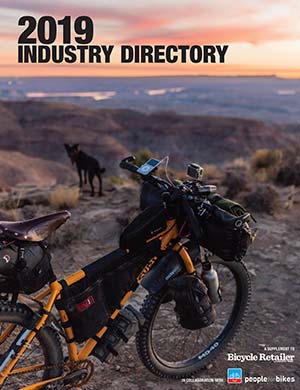Editor's note: The following article appeared in the June 15 issue of Bicycle Retailer & Industry News.
By Michael Sudmeier
For many startups, a lack of capital can cripple dreams. Entrepreneurs empty their pockets, frisk friends and family, or trade equity and control of their ideas for funding.
The three friends behind Revolights, however, pursued a different route.
Thanks to the support of 1,442 people—most of whom they have never met—Kent Frankovich, Adam Pettler and Jim Houk are bringing their new bike lighting system to market. Revolights uses a magnetic sensor and rim strips lit by LEDs to ensure cyclists are visible and to illuminate the ground in front of them. The company secured more than $215,000 through crowdfunding, a system that draws on the collective support of individuals to generate financing.
Like a growing number of inventors, entrepreneurs and artists, they secured financing through Kickstarter, which bills itself as “a funding platform for creative projects.” Individuals and organizations are turning to Kickstarter to aid in funding the creation of everything from documentaries to underwear companies to watches that sync with smartphones.
After Kickstarter reviews projects to ensure they comply with its guidelines, it posts them to its website. From there, projects attempt to garner support through their videos and stories. Projects also need a specific funding goal, with a deadline, and rewards for backers.
“With Kickstarter, there is always a value exchange—and it’s at the intersection of commerce and patronage. In exchange for your product, you get a reward, something that brings you closer to the project creator,” said Justin Kazmark, director of communications for Kickstarter.
Revolights, for example, offered five levels of rewards in its Kickstarter campaign. Backers who pledged $5 will receive a handwritten thank you from the company’s founders, while those who pitched in $200 will receive a set of Revolights in advance of them being publicly available.
Spurcycle offered its debut product, GripRings, as a reward for backers who pledged $20 or more. Replacing traditional handlebar grips, GripRings consists of a set of 16 silicone rings of customizable mix-and-match colors, as well as a pair of end plugs. To entice shops to support its project, Spurcycle offered packages of 24 sets of GripRings to backers who pledged $300 or more. These backers—and their shops—will also receive a personal thank you and recognition on Spurcycle’s landing page.
Since its inception in 2009, Kickstarter has successfully funded more than 20,000 projects. This funding has come from some 1.8 million people who have collectively pledged more than $200 million. To receive any funds, a project must meet or exceed its stated goal by its deadline. According to Kazmark, approximately 44 percent of Kickstarter projects attain successful funding. If a project is funded, Kickstarter takes 5 percent of its revenue and Amazon, which processes Kickstarter’s payments, charges an additional 3 to 5 percent.
Nonmonetary benefits
Kickstarter provides far more than just funding. “What we hear from creators frequently is that they came for the funding, but they left with an audience, and they didn’t realize how invaluable Kickstarter was as a tool to build a community around their idea,” Kazmark said.
This community is often magnified beyond those previously familiar with Kickstarter thanks to social media, networks of friends and family, and media attention. Although PumpTire did not attain funding for its self-inflating bike tire, “We were written up in over 100 online and printed media,” said founder and CEO Ben Krempel. “And we were contacted by several industry companies that we’ve since developed relationships with.”
Through its new technology and Kickstarter campaign, Ronin Bicycle Works has secured support and publicity beyond the bike industry. “We developed a way to bend metal with special perforations, a patent-pending method. It’s basically like origami,” said Andy Davies, director of design for Ronin. The company hopes to secure funding to produce its inaugural line of frames, which are crafted with sheets of aluminum, titanium or steel that are bent and then joined with rivets and auto-grade epoxy.
In addition to becoming passionate advocates for projects, backers provide valuable feedback. Kickstarter “is an incredible form of market research. People will only back projects that they are very interested in,” said Nathan Wills, who tapped Kickstarter to fund Torch, a brand whose debut product is a helmet with an integrated lighting system.
For Bike Gotham, feedback from customers has aided in refining the company’s inaugural theft-resistant bike headlight. It has also provided inspiration—and demand—for its second product, which will be a rear light.
Using the orders Kickstarter backers placed when redeeming rewards, Ashley Rankin provided retail partners with useful data for her company, Shredly. When placing orders for Shredly’s women’s mountain bike apparel, many of her 15 retail partners simply mimicked the product and size distribution of her Kickstarter orders. “I was able to say to them, ‘I’m doing this Kickstarter campaign and it’s given me a lot of insight into what people are buying,’ ” Rankin said. “I could tell them when they would place an order, ‘This is the No. 1 seller, this the No. 2 seller … .’ ”
Kickstarter isn’t just funding new industry brands. Mission Bicycle Co., for example, recently turned to Kickstarter to debut a new bike, the Sutro. “It seemed like a great way to introduce the frame to our fans, build excitement and help fund the initial production,” said Kai McMurtry, marketing specialist for the company.
Events get into the act
Cycling organizations are also turning to crowdfunding for support. Kickstarter has aided cicLAvia in securing funds for its events, which temporarily close down streets in Los Angeles to allow people to bike, skate, walk and explore the community. So far, each of its four events has benefited from Kickstarter. On April 15, an estimated 100,000 people traveled the streets along cicLAvia’s 10-mile route.
Last month, the Great Atlanta Bike Parade sought funding via Kickstarter. Held during Atlanta Streets Alive, the city’s open streets event, the parade is “an all-inclusive, artful celebration of cycling in our city,” said founder Chantelle Rytter. The event aims to blend art and cycling through its parade and by hosting art bike honorariums and free bike art workshops.
Regardless of whether they secure funding, project creators frequently serve as evangelists for Kickstarter, touting its ability to fuel innovation and creativity.
“The best ideas often come from independent inventors—gearheads—people who are bike enthusiasts that really understand what other bike enthusiasts need,” said Bike Gotham co-founder Slava Menn. “In the past, independent inventors were precluded from bringing their product to market. Kickstarter has flipped this upside down and democratized the ability for people to create and invent.”



